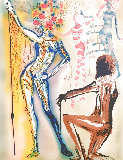


Untitled Painting 36x50 Huge
Richard Florsheim
Original Painting : Oil on Canvas
Size : 36x50 in | 91x127 cm
-
We have buyers waiting
SOLD I have one and want to sell it
Year
Hand SignedLower right
Condition Excellent
Not Framed
Certificate of AuthenticityArt Brokerage
LID107381
Richard Florsheim - United States
Art Brokerage: Richard Florsheim American Artist: b. 1916-1979. Richard Aberle Florsheim was born into a wealthy family on October 25, 1916, in Chicago, Illinois. He attended the Chicago Latin School (1923–34), and the University of Chicago (1935-36), and in the interim, studied in New York with Aaron Bohrod (1934–35). His father subsidized his independent study in France, Italy, central Europe, and the Near East (1936–38). In France he met artist Emile Bernard, and spent time in his studio and visiting museums. He exhibited in France in the late 1930s with the Salon des Refusés, and the Musée du Jeu de Paume honored him by purchasing one of his paintings, Don Quixote. In 1937, he met Helen Porfirieff. They married in 1948. By the summer of 1939, Florsheim's father no longer supported him and he returned to Chicago, renting a studio on North Avenue. He began working in lithography in 1940 and was included in a two-man show at Quest Gallery, Chicago. In 1942, Florsheim enlisted in the U.S. Navy and served in the Pacific theater as a cartographer and obtained patents for his radar plane-spotting technique. After the war, he resumed his artistic career, exhibiting widely. He helped found the Artists' League of the Midwest with Artists' Equity Association of New York, later becoming president of National Equity. In 1947–51, he exhibited at Milwaukee Art Institute and mounted two shows at Luyber Galleries, New York. He also taught at King-Smith School in Washington, DC, and Layton School of Art, Milwaukee (1949–50). With its vibrant, almost acid-tinted colors and abstracted treatment of the landscape as patterns, shapes, and hues, Harbor Lights is typical of Florsheim's modern paintings. Eliot Alexander could have been describing that work in particular when he wrote in Time magazine: "Florsheim points out that man-made lights are also a part of nature and adds new dimensions to the ordinary conception of what is beautiful." Florsheim's study of electrical light constitute what we might call today the "built environment"—emphasizing man's influence on nature. He died in 1979. Listings wanted.
































